Motaz Alfarraj
King Fahd University of Petroleum and Minerals, Electrical Engineering Department, SDAIA-KFUPM Joint Research Center for Artificial Intelligence
Recursions Are All You Need: Towards Efficient Deep Unfolding Networks
May 09, 2023



Abstract:The use of deep unfolding networks in compressive sensing (CS) has seen wide success as they provide both simplicity and interpretability. However, since most deep unfolding networks are iterative, this incurs significant redundancies in the network. In this work, we propose a novel recursion-based framework to enhance the efficiency of deep unfolding models. First, recursions are used to effectively eliminate the redundancies in deep unfolding networks. Secondly, we randomize the number of recursions during training to decrease the overall training time. Finally, to effectively utilize the power of recursions, we introduce a learnable unit to modulate the features of the model based on both the total number of iterations and the current iteration index. To evaluate the proposed framework, we apply it to both ISTA-Net+ and COAST. Extensive testing shows that our proposed framework allows the network to cut down as much as 75% of its learnable parameters while mostly maintaining its performance, and at the same time, it cuts around 21% and 42% from the training time for ISTA-Net+ and COAST respectively. Moreover, when presented with a limited training dataset, the recursive models match or even outperform their respective non-recursive baseline. Codes and pretrained models are available at https://github.com/Rawwad-Alhejaili/Recursions-Are-All-You-Need .
Meta-Optimization of Deep CNN for Image Denoising Using LSTM
Jul 14, 2021
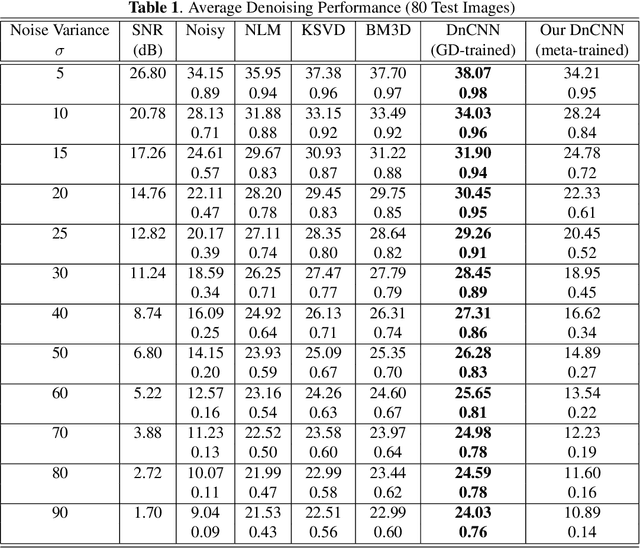
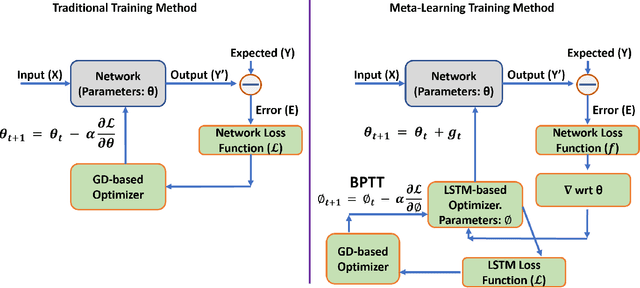
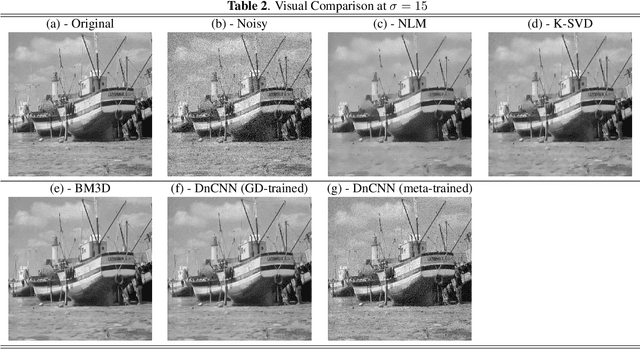
Abstract:The recent application of deep learning (DL) to various tasks has seen the performance of classical techniques surpassed by their DL-based counterparts. As a result, DL has equally seen application in the removal of noise from images. In particular, the use of deep feed-forward convolutional neural networks (DnCNNs) has been investigated for denoising. It utilizes advances in DL techniques such as deep architecture, residual learning, and batch normalization to achieve better denoising performance when compared with the other classical state-of-the-art denoising algorithms. However, its deep architecture resulted in a huge set of trainable parameters. Meta-optimization is a training approach of enabling algorithms to learn to train themselves by themselves. Training algorithms using meta-optimizers have been shown to enable algorithms to achieve better performance when compared to the classical gradient descent-based training approach. In this work, we investigate the application of the meta-optimization training approach to the DnCNN denoising algorithm to enhance its denoising capability. Our preliminary experiments on simpler algorithms reveal the prospects of utilizing the meta-optimization training approach towards the enhancement of the DnCNN denoising capability.
Spatiotemporal Modeling of Seismic Images for Acoustic Impedance Estimation
Jun 28, 2020
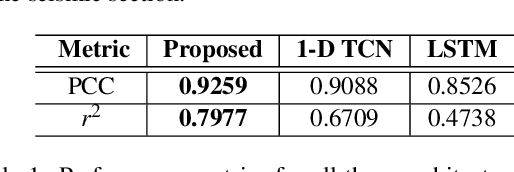
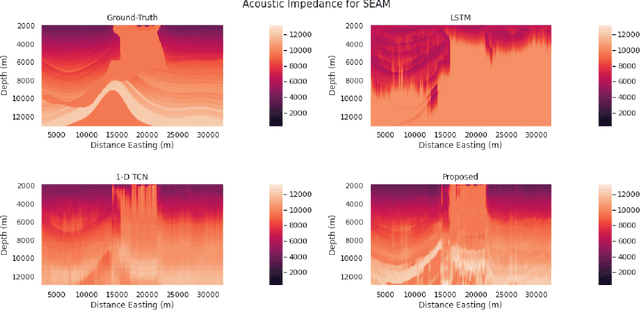
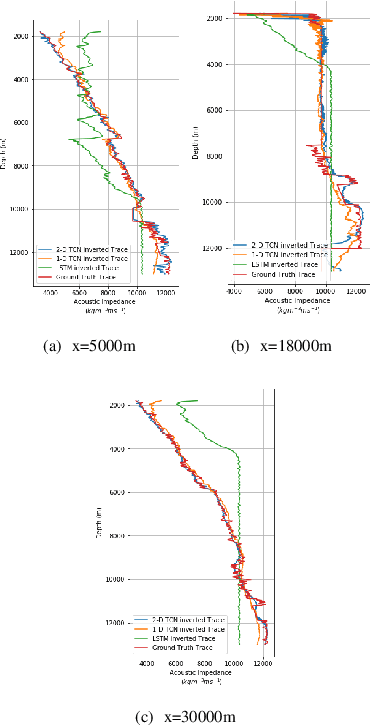
Abstract:Seismic inversion refers to the process of estimating reservoir rock properties from seismic reflection data. Conventional and machine learning-based inversion workflows usually work in a trace-by-trace fashion on seismic data, utilizing little to no information from the spatial structure of seismic images. We propose a deep learning-based seismic inversion workflow that models each seismic trace not only temporally but also spatially. This utilizes information-relatedness in seismic traces in depth and spatial directions to make efficient rock property estimations. We empirically compare our proposed workflow with some other sequence modeling-based neural networks that model seismic data only temporally. Our results on the SEAM dataset demonstrate that, compared to the other architectures used in the study, the proposed workflow is able to achieve the best performance, with an average $r^{2}$ coefficient of 79.77\%.
Fabric Surface Characterization: Assessment of Deep Learning-based Texture Representations Using a Challenging Dataset
Mar 16, 2020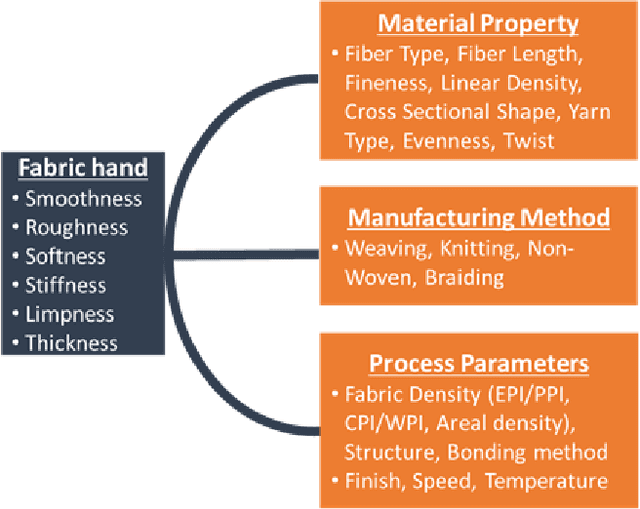

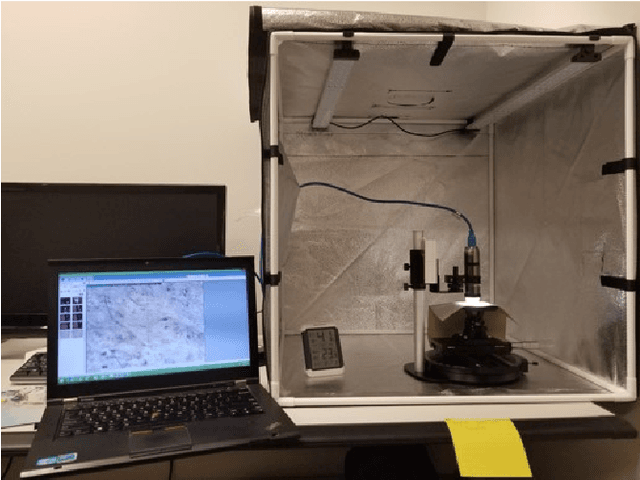
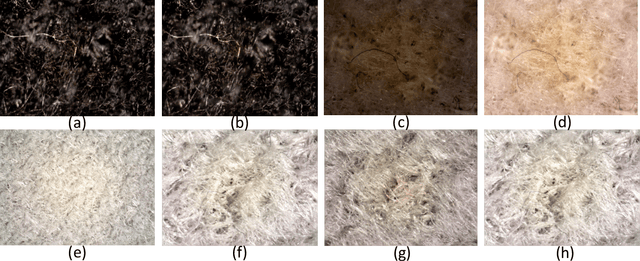
Abstract:Tactile sensing or fabric hand plays a critical role in an individual's decision to buy a certain fabric from the range of available fabrics for a desired application. Therefore, textile and clothing manufacturers have long been in search of an objective method for assessing fabric hand, which can then be used to engineer fabrics with a desired hand. Recognizing textures and materials in real-world images has played an important role in object recognition and scene understanding. In this paper, we explore how to computationally characterize apparent or latent properties (e.g., surface smoothness) of materials, i.e., computational material surface characterization, which moves a step further beyond material recognition. We formulate the problem as a very fine-grained texture classification problem, and study how deep learning-based texture representation techniques can help tackle the task. We introduce a new, large-scale challenging microscopic material surface dataset (CoMMonS), geared towards an automated fabric quality assessment mechanism in an intelligent manufacturing system. We then conduct a comprehensive evaluation of state-of-the-art deep learning-based methods for texture classification using CoMMonS. Additionally, we propose a multi-level texture encoding and representation network (MuLTER), which simultaneously leverages low- and high-level features to maintain both texture details and spatial information in the texture representation. Our results show that, in comparison with the state-of-the-art deep texture descriptors, MuLTER yields higher accuracy not only on our CoMMonS dataset for material characterization, but also on established datasets such as MINC-2500 and GTOS-mobile for material recognition.
Semi-supervised Sequence Modeling for Elastic Impedance Inversion
Aug 19, 2019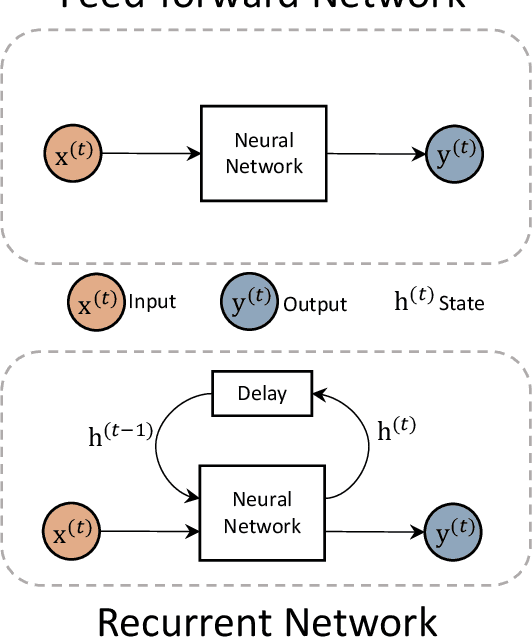
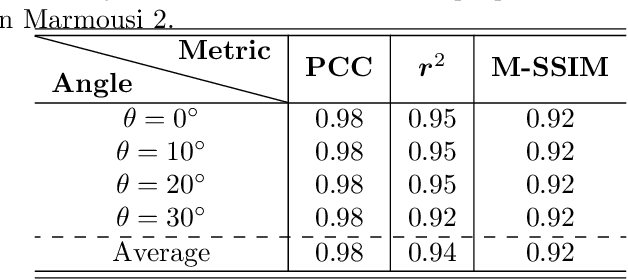
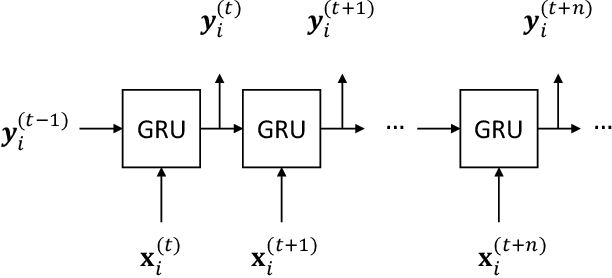

Abstract:Recent applications of machine learning algorithms in the seismic domain have shown great potential in different areas such as seismic inversion and interpretation. However, such algorithms rarely enforce geophysical constraints - the lack of which might lead to undesirable results. To overcome this issue, we have developed a semi-supervised sequence modeling framework based on recurrent neural networks for elastic impedance inversion from multi-angle seismic data. Specifically, seismic traces and elastic impedance (EI) traces are modeled as a time series. Then, a neural-network-based inversion model comprising convolutional and recurrent neural layers is used to invert seismic data for EI. The proposed workflow uses well-log data to guide the inversion. In addition, it uses seismic forward modeling to regularize the training and to serve as a geophysical constraint for the inversion. The proposed workflow achieves an average correlation of 98% between the estimated and target EI using 10 well logs for training on a synthetic data set.
Petrophysical Property Estimation from Seismic Data Using Recurrent Neural Networks
Feb 01, 2019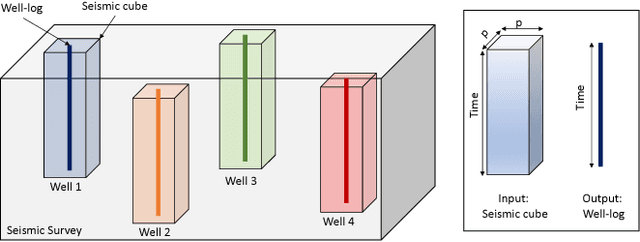

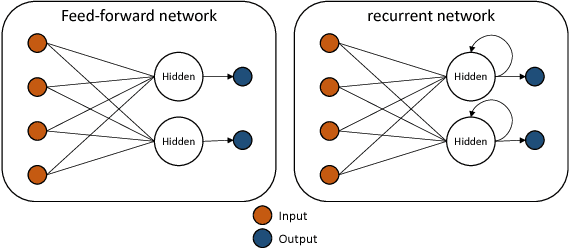
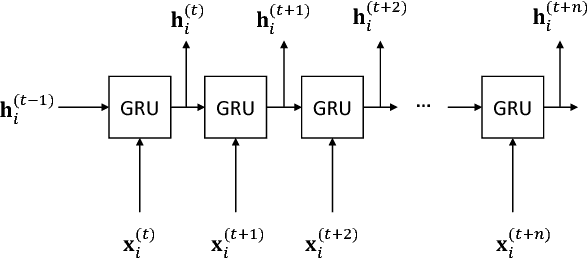
Abstract:Reservoir characterization involves the estimation petrophysical properties from well-log data and seismic data. Estimating such properties is a challenging task due to the non-linearity and heterogeneity of the subsurface. Various attempts have been made to estimate petrophysical properties using machine learning techniques such as feed-forward neural networks and support vector regression (SVR). Recent advances in machine learning have shown promising results for recurrent neural networks (RNN) in modeling complex sequential data such as videos and speech signals. In this work, we propose an algorithm for property estimation from seismic data using recurrent neural networks. An applications of the proposed workflow to estimate density and p-wave impedance using seismic data shows promising results compared to feed-forward neural networks.
A Machine Learning Benchmark for Facies Classification
Jan 12, 2019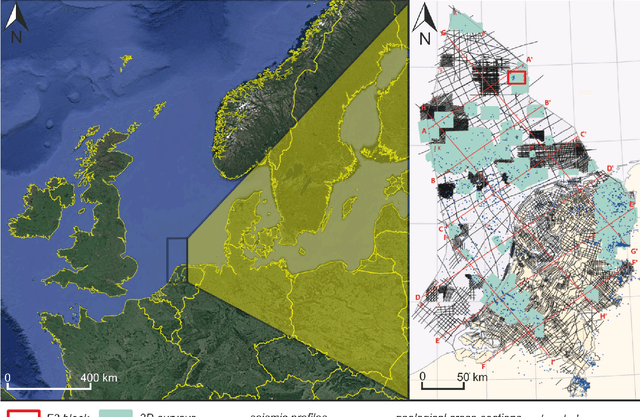

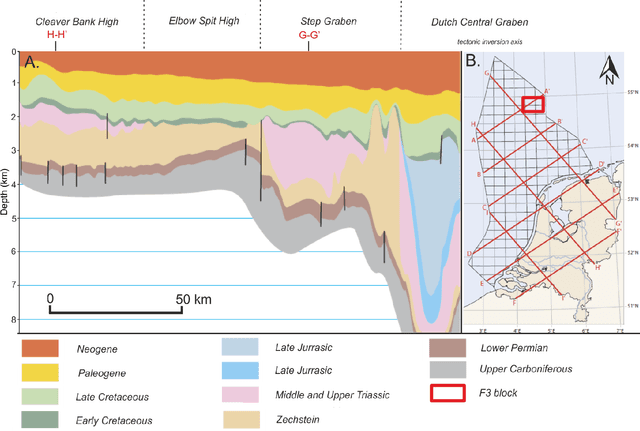

Abstract:The recent interest in using deep learning for seismic interpretation tasks, such as facies classification, has been facing a significant obstacle, namely the absence of large publicly available annotated datasets for training and testing models. As a result, researchers have often resorted to annotating their own training and testing data. However, different researchers may annotate different classes, or use different train and test splits. In addition, it is common for papers that apply deep learning for facies classification to not contain quantitative results, and rather rely solely on visual inspection of the results. All of these practices have lead to subjective results and have greatly hindered the ability to compare different machine learning models against each other and understand the advantages and disadvantages of each approach. To address these issues, we open-source an accurate 3D geological model of the Netherlands F3 Block. This geological model is based on both well log data and 3D seismic data and is grounded on the careful study of the geology of the region. Furthermore, we propose two baseline models for facies classification based on deconvolution networks and make their codes publicly available. Finally, we propose a scheme for evaluating different models on this dataset, and we share the results of our baseline models. In addition to making the dataset and the code publicly available, this work can help advance research in this area and create an objective benchmark for comparing the results of different machine learning approaches for facies classification for researchers to use in the future.
A comparative study of texture attributes for characterizing subsurface structures in seismic volumes
Dec 19, 2018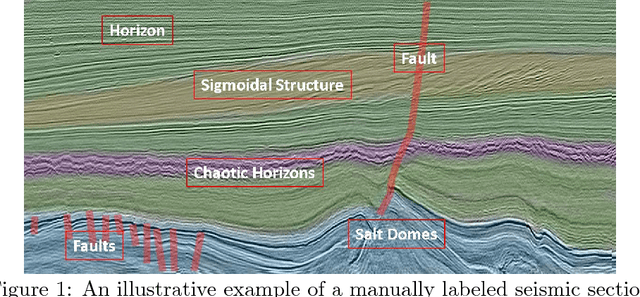
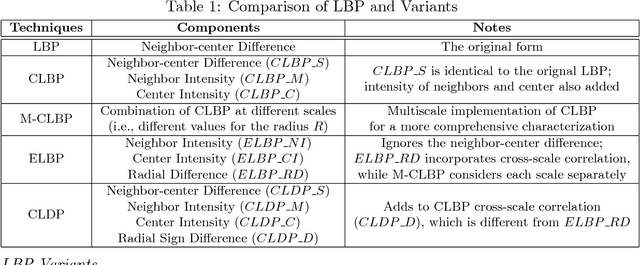
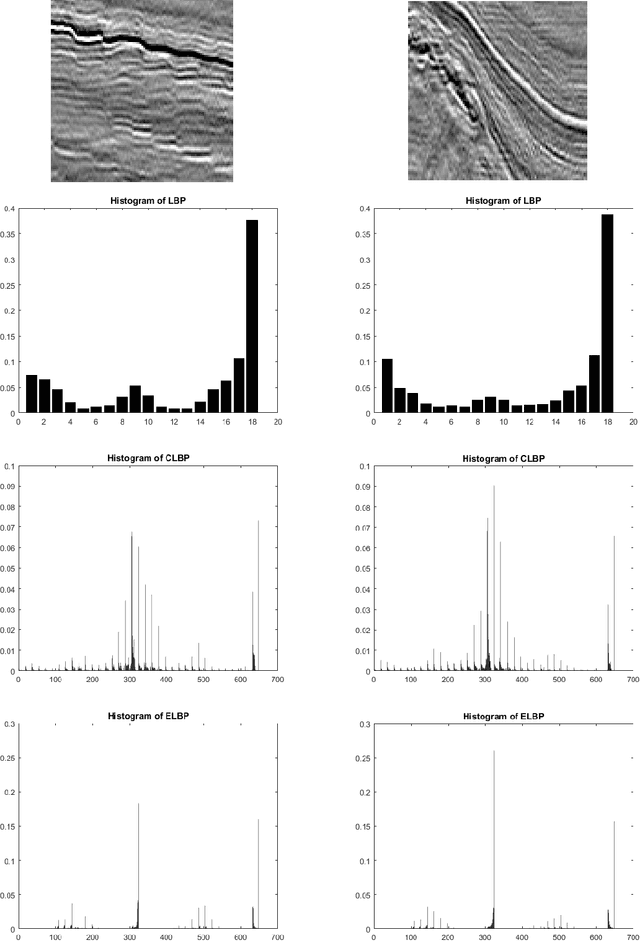

Abstract:In this paper, we explore how to computationally characterize subsurface geological structures presented in seismic volumes using texture attributes. For this purpose, we conduct a comparative study of typical texture attributes presented in the image processing literature. We focus on spatial attributes in this study and examine them in a new application for seismic interpretation, i.e., seismic volume labeling. For this application, a data volume is automatically segmented into various structures, each assigned with its corresponding label. If the labels are assigned with reasonable accuracy, such volume labeling will help initiate an interpretation process in a more effective manner. Our investigation proves the feasibility of accomplishing this task using texture attributes. Through the study, we also identify advantages and disadvantages associated with each attribute.
 Add to Chrome
Add to Chrome Add to Firefox
Add to Firefox Add to Edge
Add to Edge